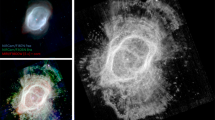Abstract
The physical nature and evolution of the Orion Nebula has begun to be revealed by calibrated emission line images and high resolution spectroscopy. We review the evidence that the nebula is a thin wall of emission on the near side of the Orion Molecular Cloud and that its separation from the dominant ionizing star is about 0.3 pc. The density of the nebula decreases rapidly away from the ionization front and the ionized gas is moving at 8 km s−1 away from the front. A three dimensional model of the surface is presented and its peaks and valleys interpreted as due to irregularities in the density of the molecular cloud. The front is moving rapidly into the molecular cloud, so that objects previously shielded from ionization are continuously being revealed. Recent Hubble Space Telescope images are reviewed and they indicate that protoplanetary disks around pre-main sequence stars are both common and rendered visible by ionization and projection against the bright nebula. A large body of velocity data is discussed and it is seen that Kolmogorov type turbulence seems to only apply to material in the ionization front and the statistical fluctuations become less correlated away from the front.
Similar content being viewed by others
References
Allen, D. A. & M. G. Burton 1993,Nature,363, 54.
Axon, D. J. & Taylor, K. 1984,MNRAS,207, 241
Baldwin, J. A., Ferland, G. J., Martin, P. G., Corbin, M. R., Cota, S. A., Peterson, B. M., & Sletteback, A. 1991,ApJ, bf 374, 580
Castañeda, H. O. 1988,ApJS,67, 93
Dopita, M. A., Dyson, J., & Meaburn, J. 1974,ApSS, 28, 61
Dyson, J. E. 1968a,ApSS,1, 388
Dyson, J. E. 1968b,ApSS,2, 461
Dyson, J. E. 1975,ApSS,35, 299
Escalante, V., Sternberg, A., & Dalgarno, A. 1991,ApJ,375, 630
Felli, M., Churchwell, E., Wilson, T., & Taylor, G. B. 1993,A&AS,98, 137
Goudis, C. 1982,The Orion Complex: A case Study of Interstellar Matter (Dordrecht: Reidel)
Herbig, G. H. 1982,Ann.NY Acad.Sci,395, 64
Herbig, G. H. & Terndrup, D. M. 1986,ApJ,307, 609
Hester, J. J. 1991,PASP, bf 103, 853
Hester, J. J., Dufour, R. J., Parker, R. A. R., & Scowen, P. A. 1991a,BAAS,23, 1364
Hester, J. J.et al. 1991b,ApJ,369, L75
Hoffleit, Dorrit 1964,Bright Star Catalogue (New Haven, CN: Yale Observatory)
Joncas, G. & Roy, J. R. 1986,ApJ,307, 649
Jones, M. R. 1992,PhD Thesis, Rice University, Houston, TX
Laques, P. & Vidal, J. L. 1979,A&A,73, 97
Meaburn, J. 1988,MNRAS,233, 791
Meaburn, J. & Massey, R. M. 1993,MNRAS, in press
Meaburn, J., Massey, R. M., Raga, A. C. & Clayton, C. A. 1993,MNRAS,260, 625
Münch, G. 1958,Rev.Mod.Phys.,30, 1035
O'Dell, C. R. 1993,Revista Mex A&Ap, in press
O'Dell, C. R. & Castañeda, H. O. 1987,ApJ,315, L55
O'Dell, C. R., Townsley, L. K., & Castañeda, H. O. 1987,ApJ,317, 676
O'Dell, C. R., Wen, Zheng, & Hester, J. J. 1991,PASP,103, 824
O'Dell, C. R., Walter, D. K., & Dufour, R. J. 1992,ApJ,399, L67
O'Dell, C. R. & Wen, Zheng 1992,ApJ,387, 229
O'Dell, C. R., Valk, J. H., Wen, Zheng, & Meyer, D. M. 1993a,ApJ,403, 678
O'Dell, C. R., Wen, Zheng, & Hu, Xihai 1993b,ApJ,411, 696
Osterbrock, D. E. & Flather, E. 1959,ApJ,129, 26
Osterbrock, D. E. 1989,Astrophysics of Gaseous Nebulae and Active Galactic Nuclei (Mill Valley: University Science Books)
Pogge, R. W., Owen, J. M., & Atwood, B. 1992,ApJ,399, 147
Roy, J. R., Arsenault, R., & Joncas, G. 1986,ApJ,300, 624
Rubin, R. H., Simpson, J. P., Haas, M. R., & Erickson, E. F.ApJ,374, 564
Schiffer, F. H., III & Mathis, J. S. 1974,ApJ,194, 597
Strand, K. Aa 1958,Ann.Dearborn Obs.,7, 67
Tielens, A. G. G. M. & Hollenbach, D. 1985,ApJ,291, 747
van Altena, W. F., Lee, J. T., & Lee, J.-F. 1988,AJ,95, 1744
van der Werf, P. P. & Goss, W. M. 1989,A&A,224, 209
van der Werf, P. P. & Goss, W. M. 1990,ApJ,364, 157
von Hoerner, S. 1951,Zs.Ap.,30, 17
Walter, D. K. 1993,PhD Thesis, Rice University, Houston, TX
Wen, Zheng & O'Dell, C. R. 1993,ApJ,409, 262
Wen, Zheng 1993,PhD Thesis, Rice University, Houston, TX, in preparation
Wilson., O. C., Münch, G., Flather, E. M., & Coffeen, M. F. 1959,ApJS,4, 199
Yorke, H. W 1986,ARAA,24, 49
Author information
Authors and Affiliations
Rights and permissions
About this article
Cite this article
O'Dell, C.R. The Orion Nebula: structure, dynamics, and population. Astrophys Space Sci 216, 267–280 (1994). https://doi.org/10.1007/BF00982504
Received:
Issue Date:
DOI: https://doi.org/10.1007/BF00982504




